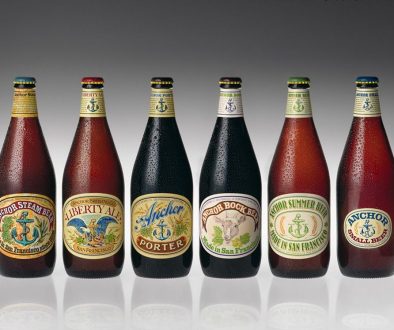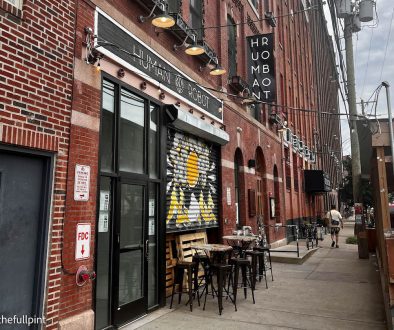Rundown of Craft Beer Gimmicks and Trends
 As craft beer gets closer to mainstream, it will be a friendly fight for craft brewers to get shelf space at their chosen retailers. Forget the uphill battle against the macro breweries, with all the bottled and canned beers out there, a beer not only has to have a tasty reputation, it also has to jump out at you, in effort to grab your dollars. Here is a run down of all the gimmicks and trends I’ve noticed as a craft beer consumer. Some breweries have made these work for them, and some have me feeling a tad cynical. Cheers, Dan
As craft beer gets closer to mainstream, it will be a friendly fight for craft brewers to get shelf space at their chosen retailers. Forget the uphill battle against the macro breweries, with all the bottled and canned beers out there, a beer not only has to have a tasty reputation, it also has to jump out at you, in effort to grab your dollars. Here is a run down of all the gimmicks and trends I’ve noticed as a craft beer consumer. Some breweries have made these work for them, and some have me feeling a tad cynical. Cheers, Dan
Corked and Caged 750 Ml Bottles – Typically, you will find imported Belgian beers presented in a 750 ml bottle, and it will be sealed with a cork and a wire cage. It looks far better than a metal crown in most cases, and signifies to the consumer that this beer is being portrayed as something as fancy as wine. In the last few years, companies like Boulevard, Sierra Nevada and Uinta Brewing have gotten in on the fancy corked bottle action. Verdict: The beer on the inside still has to be as premium as the packaging. I have no problem paying an extra few bucks for the aesthetics if it puts the cherry on top of a fantastic beer. If the beer itself is sub par, I feel the brewery should be focusing on that rather than the facade of a premium product.
Waxed 22 oz. Bottles – The midwest juggernauts are notorious for putting a coating of colored wax on the neck of their 22 oz. bottles. 3 Floyds does it for Dark Lord and Behemoth, Surly does it for Darkness and their anniversary beers, even Flossmoor Station has given it a whirl. As a consumer, it signifies this beer is special, possibly rare, collectible, and something you may want to cellar. Verdict: I love the way it looks, I like that it gives the beer another layer of seal. I think it should be used for special occasions, as it typically is. Sierra Nevada dipped their Chico Estate into green wax, and it caused an uproar, with the line of thinking that the beer could have been priced better without the wax treatment. We found out it wasn’t the case, but that was the taste left in the consumers mouth.
Barrel Aged – Everything is better with bacon? Everything is better barrel aged? Allagash and Lost Abbey brewing made barrel aging strong ales a really popular trend amongst craft beer in the US. I’ll be the first to admit I’m a sucker for a barrel aged Imperial Stout, as a fresh or spirit soaked barrel brings a new level of flavor and complexity to a beer. We’ve been told by the handful of brewers that barrel age beers that it’s not cost efficient to produce these treats. The barrels cost more than stainless steel, and the aging process takes up room and time, with the risk of the beer going bad due to a bug in the barrel. Verdict: As mentioned, I’m a big sucker for anything barrel aged, and am willing to kick down a few more dollars for it. With that said, I don’t appreciate short stays in the barrel for the sake of saying your beer is barrel aged, and I also don’t appreciate lighter bodied beers being aged in Bourbon barrels. Easily one of my favorite gimmicks all and all.
Rye IPA – Here is a trend I don’t understand, and am sure to research further now that I’m talking about it; the Rye IPA. One of Terrapin Brewing’s flagship beer is a Rye IPA, and doing an online search will yield many results of this type of IPA. I know the rye malt is supposed to lend an earthier flavor, and a slightly different texture compared to it’s malted barley counter part. The thing is, the star of the IPA show is the hops, and more times than not, the rye aspect is buried underneath the IBUs. Verdict: I’m open to being schooled on this, but as it stands, I’ll take a regularly marked IPA over something marked Rye IPA.
Collaborations – 4 years ago, Dogfish,Avery,Lost Abbey,Allagash and Russian River teamed up to create Isabelle Proximus. Since then, the world of beer collaborations has gone into overdrive. Stone Brewing releases a collaboration beer every 4 to 6 months, Oakshire teams up with 5 other brewers every year for Collaborative Evil, and every day, a new collaboration seems to be announced by somebody. The amount of craft beer collaborations seems to be doubling each year Verdict: There will be a point where this gimmick has jumped the shark, if it hasn’t already. I’ve had some amazing beers from the Stone Collaborations program, especially Saison DuBuff, so I am thankful in that regard, it just comes off as more marketing than brewing creativity. If you like X brewery and you like Y brewery, You’ll LOVE XY Collaboration.
Canned Craft – Oskar Blues changed the perception of canned beer a few years ago. Oskar Blues and Maui Brewing found great efficiency in putting well crafted beer in an aluminum can. This allowed for quicker packaging, less expensive shipping, and preservation of the precious delicate beer inside. Another advantage of the craft can is the ability to utilize 100% of the outside surface for catchy art. Since OB and Maui have been blazing the trail, dozens of breweries began switching over to this model, going from bottling to canning, retiring their boring bottle labels in favor of bright colorful shiny cans. Verdict: It’s a wonderful gimmick/trend for many of the reasons mentioned above. I love fresh beer, I hate skunked beer. One thing of note is, while the breweries are saving a little bit of money going with this method, the savings don’t seem to be passed onto the consumer. Unfortunately for the breweries canning, there’s still a perception that cans should cost less than bottles, even though you are buying what’s on the inside of the package.
Limited Release – There is a market and gray market for hard to get beer. Usually, the limited release beer/special release beer uses other gimmicks listed above such as the cork and cage, barrel aging, etc. The reason these beers are typically filed under limited or special release, is that the beer was labor intensive and yielded a small amount. Verdict: I am a collector/drinker of limited release beers. I look forward to trying these rare treats. I’m not a fan of said beers turning into baseball cards or beanie babies, nor am I a fan of a beer being rated highly based on it’s rareness.
Black IPA– 2010 might have gone down as the year of the Black IPA. Shortly after Stone Brewing did Sublimely Self Righteous Ale, brewers and beer drinkers took notice of a beer that tastes like a hoppy IPA, but looks like a black porter. If there was ever an ultimate craft beer gimmick, it would be this. As more and more breweries put their name in the Black IPA hat, a mini campaign started out of the Pacific Northwest region of the US, in which breweries lobbied for this style of beer to be called Cascadian Dark Ale or CDA. The labeling would allow for the region to pat themselves on the back for being a hop growing area of the country, as well as having a beer style identified with their territory. I don’t believe CDA has caught on, as the Brewers Association called it Black IPA, then modified it to American-style Black Ale. Verdict: I’ve had more “Black IPAs” that were simply thin bodied porters. If you are going to jump on the Black IPA bandwagon, make a black colored IPA please.
Dry Hopping – Not to be confused with Miller’s “Triple Hopped Brewed” campaign, the term Dry-hopped has been popping up more and more lately. Dry-hopping is adding hops after you have boiled your brew, which can be added during fermentation process or during it’s conditioning stage. This isn’t to add bitterness to the beer, but rather adds considerable amounts of aroma to your beer. Whether you know it or not, most of the hoppy beers you enjoy have undertook this process. Verdict: While the term isused as a gimmick to make hop heads mouth water, it’s really one of the main reasons west coast IPAs are so damn good. I’m hoping along with using the term, some education is spread on this beer making technique.
We encourage you to leave feedback on this topic. If you are interested in penning a guest blog, please contact us using our contact form. Cheers




June 13, 2011 @ 1:16 am
A bottle doesn’t have to be corked to undergo secondary fermentation.
Alas, the insidious specter of marketing has gotten into craft beer, which for the most part is a legitimate and ethical industry. Black IPA’s meh. Same with rye beers.
Limited or seasonal releases are good with me.
Barrel aged is a preference thing…I really like Bernt’s take on that and have nothing to add. He nailed it.
I have a high opinion of collaborations so far but it does seem this article is prescient…I’m not sure there’s enough shelf space for to many of these things to continue to happen and breed like locusts.
Canned seems like the way of the future…easier and less costly to ship, better ensures beer quality, etc…I’m down with it but the concerns stated are duly noted and agreed with. Once people get it through their head they aren’t buying Bud Light I think they’ll come around.
Overall, I’m becoming much more cognizant of and drawn to great beers with reasonable price points…Hop Stoopid from Lagunitas is a great value as are Angel City’s Stritch Stout and Belgian Night Train. Others are the recent release of Stone IRS, some of the Bear Republic stuff and there’s others. Some expensive stuff I’ll pay for, but much of it isn’t worth it to me…I love beer, but it’s beer.
Great article!
June 9, 2011 @ 10:02 am
po4040 – Completely forgot about Founder’s Red’s Rye – even though I have 2 or 3 in stock at home. Whoops!
June 9, 2011 @ 2:33 am
Good article, agree on most points except the Barrel Aged (BA) beers – and for two reasons:
1) Barrel aging often masks the beer.
I usually find that BA beers have little left of the aroma and flavor profile of the original brew, in particular when using Bourbon or Islay whisky casks. In those situation, you can start with a really low quality beer and still end up with the same aroma and flavor as if you used a world class beer. I do like BA myself, but only when it adds complexity to a good beer – ref Lost Abbey The Angel’s Share 2009 (Brandy BA) – not when it masks the original brew.
2) Hyperflation of beer types
What really gets to me about BA beers is the plethora of “new” beers that we “beer geeks” must hunt down, often at inflated prices. Take Mikkeller, as an example, his Beer Geek Brunch Weasel – that I find pretty good as a normal beer – has been BA in seven different casks (Bourbon, Islay, Port, Madeira, Calvados etc) on my latest count. What’s the point? It confuses a lot of not-so-geeky beer drinkers and some of these BA beers aren’t even good, ruining a perfectly good beer.
So, in my opinion, BA has gone too far. I do like a *good* BA beer, from time to time, but would much rather see the breweries focus on making great non-BA beers and only BA for special occasions.
June 8, 2011 @ 4:21 pm
When it comes to wired/corked bottles, the reason is that most of these ales are bottled conditioned during second fermentation; so it’s not really about the aesthetics. I agree with Justin Bear Republic’s Hop Rod Rye kicks ass. Another Rye IPA to try is Founder’s Reds Rye.
June 8, 2011 @ 12:52 pm
Generally agree, but I’d like to note that only so many corked/caged bottles can find space in the fridge compared to nearly every other bottle type. It’s occasionally frustrating when they are relegated to the door and I have company, leading me to rotate beer in when one gets poured.
June 8, 2011 @ 12:45 pm
Regarding Rye IPAs, Bear Republic Hop Rod Rye is truly an amazing beer, and usually not expensive(I live in the DC market).
http://www.bearrepublic.com/ourbeers.php